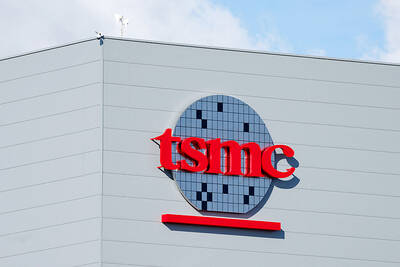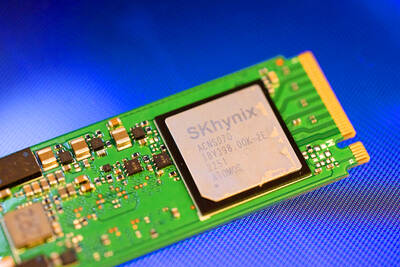Set in 2019, cult 1980s movie Blade Runner envisaged a neon-stained landscape of bionic “replicants” genetically engineered to look just like humans.
So far that has failed to materialize, but at a secretive research institute in western Japan, wild-haired roboticist Hiroshi Ishiguro is fine-tuning technology that could blur the line between human and machine.
Highly intelligent, self-aware and helpful around the house — the robots of the future could look and act just like humans and even become their friends, Ishiguro and his team predict.

Photo: AFP
“I don’t know when a Blade Runner future will happen, but I believe it will,” the Osaka University professor told reporters.
“Every year we’re developing new technology — like deep learning, which has improved the performance of pattern recognition,” he said. “Now we’re focusing on intention and desire, and if we implement them into robots whether they become more human-like.”
Robots are already widely used in Japan — from cooking noodles to helping patients with physiotherapy.
Marketed as the world’s first “cyborg-type” robot, HAL (hybrid assistive limb) — developed by the University of Tsukuba and Japan-based Cyberdyne Inc — is helping people in wheelchairs walk again using sensors connected to the unit’s control system.
Scientists believe service robots will one day help humans with household chores, from taking out the garbage to making the perfect slice of toast.
Stockbrokers in Japan and around the world are already deploying artificial intelligence (AI) bots to forecast stock market trends and science fiction’s rapid advance toward science fact owes much to the likes of Ishiguro.
He previously created an android copy of himself — using complex moving parts, electronics, silicone skin and his own hair — that he sends on business trips in his place.
However, Ishiguro believes that recent breakthroughs in robotics and AI will accelerate the synthesis of human and machine.
“As a scientist, I hope to develop self-conscious robots like you see in Blade Runner to help me understand what it is to be human,” Ishiguro said. “That’s my motivation.”
The point at which that line between humans and machines converges has long been a source of anxiety for some, as depicted in popular culture.
In Blade Runner, Harrison Ford plays a police officer who tracks down and kills replicants that have escaped and are living among the population in Los Angeles.
The Terminator series starring Arnold Schwarzenegger centers on a self-aware computer network that initiates a nuclear holocaust and, through autonomous military machines, wages war against the remnants of humanity.
“I can’t understand why Hollywood wants to destroy robots,” said Ishiguro, who in 2007 was named one of the top 100 living geniuses by global consultants firm Synectics Ltd.
“Look at Japanese cartoons and animations — robots are always friendly. We have a totally different cultural background,” he added.
It is not just Hollywood that has concerns over AI.
Tesla Inc CEO Elon Musk has called for a global ban on killer robots, warning that technological advances could revolutionize warfare and create new “weapons of terror” that target innocent people.
However, Ishiguro insisted that there is no inherent danger in machines becoming self-aware or surpassing human intelligence.
“We don’t need to fear AI or robots, the risk is controllable,” Ishiguro said. “My basic idea is that there is no difference between humans and robots.”
The ultimate goal, according to Ishiguro’s colleague Takashi Minato, is “to bring robots into society as human companions — it’s possible for robots to become our friends.”
However, will they look like humans, as Ishiguro believes, and how comfortable will people feel surrounded by autonomous humanoids?
Japanese roboticist Masahiro Mori in 1970 suggested that the more robots resemble people, the creepier people will find them — a phenomenon he called the “uncanny valley.”
Ishiguro’s first attempt at creating an android clone was based on his daughter and its “jerky movements” reduced her to tears.
He has since perfected the template, including a creation he claimed was the world’s first news-reading android and a robot priest at a temple in Kyoto, Japan, unveiled earlier this year.
Minato shares his boss’ visionary ideas.
“Hopefully remote control technology will develop to allow our alter egos to lead regular lives,” Minato said.
“Like in the movie Surrogates — that would make life more convenient,” he added, referencing the hit science fiction film starring Bruce Willis, in which people cocooned at home experience lives through robotic avatars.
While he would not put a date on a real-life Blade Runner future, Ishiguro claimed that the rise of the machines has already begun.
“Already computers are more powerful than humans in some cases,” he said. “Technology is just another means of evolution. We are changing the definition of what it is to be human.”

Taiwan Semiconductor Manufacturing Co (TSMC, 台積電) secured a record 70.2 percent share of the global foundry business in the second quarter, up from 67.6 percent the previous quarter, and continued widening its lead over second-placed Samsung Electronics Co, TrendForce Corp (集邦科技) said on Monday. TSMC posted US$30.24 billion in sales in the April-to-June period, up 18.5 percent from the previous quarter, driven by major smartphone customers entering their ramp-up cycle and robust demand for artificial intelligence chips, laptops and PCs, which boosted wafer shipments and average selling prices, TrendForce said in a report. Samsung’s sales also grew in the second quarter, up

On Tuesday, US President Donald Trump weighed in on a pressing national issue: The rebranding of a restaurant chain. Last week, Cracker Barrel, a Tennessee company whose nationwide locations lean heavily on a cozy, old-timey aesthetic — “rocking chairs on the porch, a warm fire in the hearth, peg games on the table” — announced it was updating its logo. Uncle Herschel, the man who once appeared next to the letters with a barrel, was gone. It sparked ire on the right, with Donald Trump Jr leading a charge against the rebranding: “WTF is wrong with Cracker Barrel?!” Later, Trump Sr weighed

HEADWINDS: Upfront investment is unavoidable in the merger, but cost savings would materialize over time, TS Financial Holding Co president Welch Lin said TS Financial Holding Co (台新新光金控) said it would take about two years before the benefits of its merger with Shin Kong Financial Holding Co (新光金控) become evident, as the group prioritizes the consolidation of its major subsidiaries. “The group’s priority is to complete the consolidation of different subsidiaries,” Welch Lin (林維俊), president of the nation’s fourth-largest financial conglomerate by assets, told reporters during its first earnings briefing since the merger took effect on July 24. The asset management units are scheduled to merge in November, followed by life insurance in January next year and securities operations in April, Lin said. Banking integration,

LOOPHOLES: The move is to end a break that was aiding foreign producers without any similar benefit for US manufacturers, the US Department of Commerce said US President Donald Trump’s administration would make it harder for Samsung Electronics Co and SK Hynix Inc to ship critical equipment to their chipmaking operations in China, dealing a potential blow to the companies’ production in the world’s largest semiconductor market. The US Department of Commerce in a notice published on Friday said that it was revoking waivers for Samsung and SK Hynix to use US technologies in their Chinese operations. The companies had been operating in China under regulations that allow them to import chipmaking equipment without applying for a new license each time. The move would revise what is known